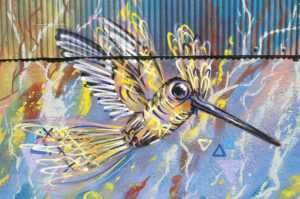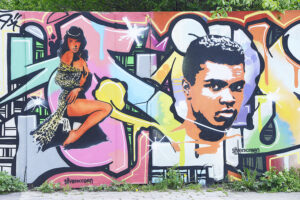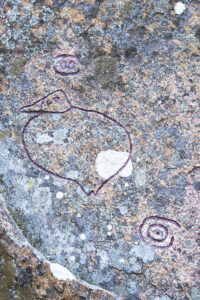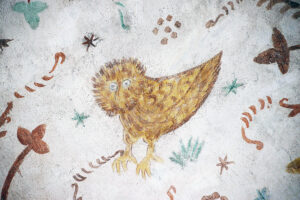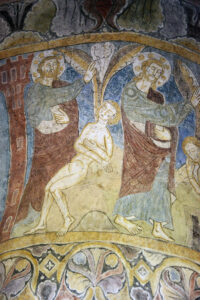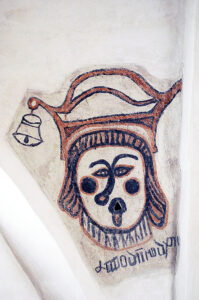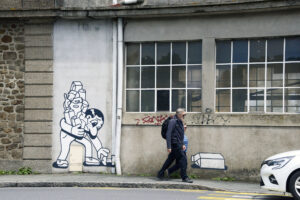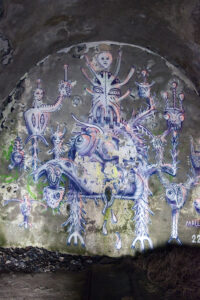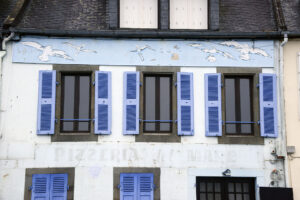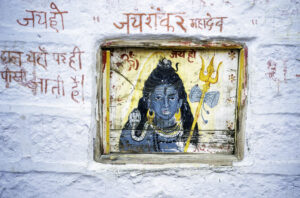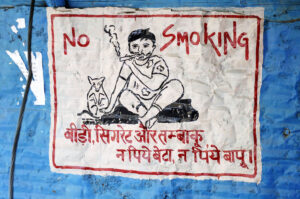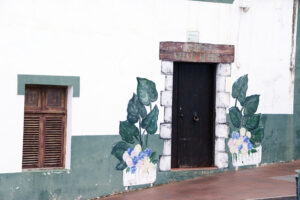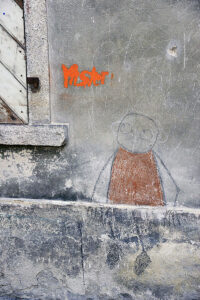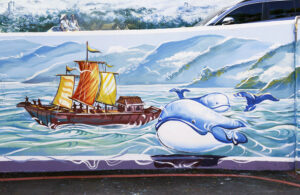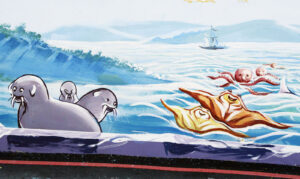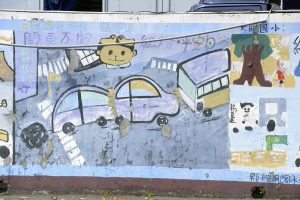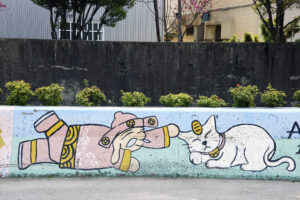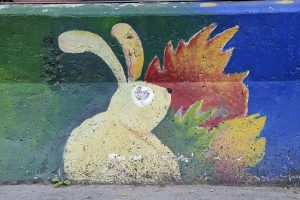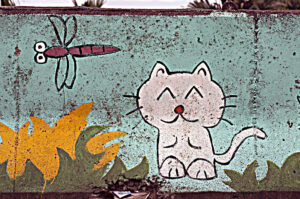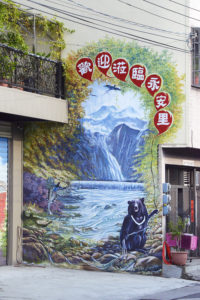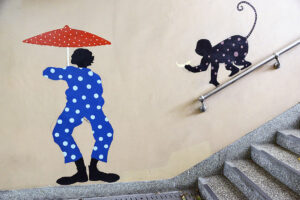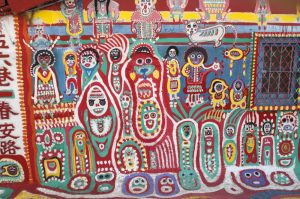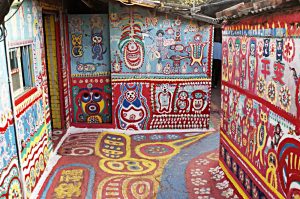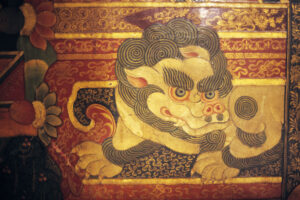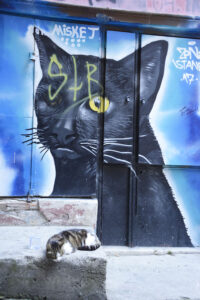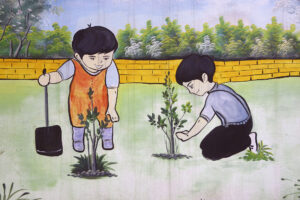Wall and rock paintings, and petroglyphs
Kitschy wall painting at a restaurant in the Bluntau Valley, near Golling, Salzburg, Austria, depicting brown bears (Ursus arctos), a capercaillie (Tetrao urogallus), and a medieval hunter. (Photo copyright © by Kaj Halberg)
Elmelunde Church, on the island of Møn, Denmark, is adorned with countless murals, painted around 1480 by an unknown artist, who has been labelled ‘The Elmelunde Master’. This painting depicts Eve’s ‘birth’. (Photo copyright © by Kaj Halberg)
Wall painting in the city of Haverhill, northern Massachusetts, United States, depicting a boxing match. (Photo copyright © by Kaj Halberg)
In Saletto, Dolomites, Italy, I encountered this fine wall painting, depicting a chamois (Rupicapra rupicapra). (Photo copyright © by Kaj Halberg)
Wall painting in Hanoi, Vietnam, depicting a scribe at work in the old days. (Photo copyright © by Kaj Halberg)
Numerous house walls and gables around the world are decorated with paintings.
On this page, I also include other paintings in public places, for instance tall crash barriers along roads, murals inside churches, etc.
Rock paintings and petroglyphs, created by ancient peoples, are included, and also images, created by scraping off the so-called desert varnish (see India and the United States).
The pictures are arranged alphabetically according to country name.
Austria
An ancient Christian legend relates that a giant made a living by carrying people across a river. One day, a little boy called him to be carried across. The giant put the child on his shoulders, grabbed his staff, and entered the river. As he was approaching the opposite shore, his burden felt heavier and heavier. The giant leaned heavily on his staff, staggering on, while he was wondering how a little child could be so heavy. With a huge effort, he dragged himself ashore, setting down the child, who said: “I am Christ, and on your back you have just carried all the sins of humankind.”
From that day, the giant was called Christopher, from the Greek Christoforos (’Christ Bearer’). Later, he was sanctified, becoming the protector of wayfarers.
The legend of Saint Christopher, depicted in a wall painting in the church in the village of Obermauern, Virgental, Tyrol. (Photo copyright © by Kaj Halberg)
Mural, depicting bakers at work, Friesach, Steiermark. (Photo copyright © by Kaj Halberg)
Chile
Wall painting, depicting colourful houses, and a boy, flying a kite, Valparaiso. (Photo copyright © by Kaj Halberg)
In central Chile, I encountered an abandoned house, which was full of wall paintings.
This caricature depicts Augusto José Ramón Pinochet Ugarte (1915-2006), dictator of Chile 1973-1990. His nickname was Pinocchio. (Photo copyright © by Kaj Halberg)
Naked lady. (Photo copyright © by Kaj Halberg)
Frangipani (Plumeria rubra) is a smallish tree of the dogbane family (Apocynaceae), native to Mexico, Central America, and northernmost South America, but due to its wonderful fragrant flowers it has been introduced as an ornamental plant to almost all tropical and subtropical countries. In Asia, it is known as temple tree, as it is often planted near Buddhist and Hindu temples.
Wall painting, depicting a lady with frangipani flowers in her hair, Valparaiso. (Photo copyright © by Kaj Halberg)
Hummingbird – detail of the painting above. (Photo copyright © by Kaj Halberg)
Costa Rica
Tortuguero is a small village, situated on an island in Tortuguero National Park on the north-western shore of Costa Rica. Many of the inhabitants are very creative, which is obvious from the pictures below.
Wall paintings in Tortuguero. (Photo copyright © by Kaj Halberg)
Six subspecies of Geoffroy’s spider monkey (Ateles geoffroyi), also known as black-handed or Central American spider monkey, are distributed from south-eastern Mexico eastwards to Panama. It mainly occurs in evergreen rainforest, but may also be found in deciduous forest. Pictures, depicting this species, can be seen on the page Animals – Mammals: Mammals in Costa Rica and Guatemala.
The brown-throated sloth (Bradypus variegatus) has a very wide distribution, found from Honduras southwards to eastern Peru, northern Bolivia, and southern Brazil.
This wall painting in Tortuguero depicts a Geoffroy’s spider monkey and a brown-throated sloth, with the following slogan, Tortuguero es pura vida (‘Tortuguero is pure life’). (Photo copyright © by Kaj Halberg)
Painting on a church wall in Puerto Jiménez, Peninsula de Osa, depicting St. Francis of Assisi with a white horse and a scarlet macaw (Ara macao). The latter was hardly known in Italy in the 1200s! (Photo copyright © by Kaj Halberg)
Wall painting in a restaurant, Old Market, San José. (Photo copyright © by Kaj Halberg)
Denmark
The free city of Christiania, Copenhagen, was established in 1971, when a group of hippies, slum stormers, and homeless people occupied a number of empty buildings in a former military barrack.
From the beginning, this area has been characterized by experiments within architecture and ways of living, and the place was also soon known as a ‘free’ area for trading hashish. Unfortunately, criminal elements also used Christiania to sell hard drugs, and for this reason the controversial area has always been characterized by confrontations between criminals and the police.
In 2004, the Danish parliament passed a law regarding normalization of the free city. The listed buildings should be fixed up, and illegally constructed buildings must be removed. However, Christiania was still to be preserved as a district with possibilities to live alternatively, and to continue the social and cultural activities of the area.
In 2011, a foundation called Fristaden Christiania (’Free city of Christiania’) was established, and it was able to acquire the area from the state, partly financed by shares. In 2012, about 900 people lived in Christiania, and the area is visited annually by around half a million tourists.
These wall paintings, depicting voluptuous and beautiful women, Muhammad Ali, and Fidel Castro, were observed on the wall around Christiania, and on one of its house walls. (Photos copyright © by Kaj Halberg)
In Denmark, Bronze Age petroglyphs are mostly found on the island of Bornholm, in the Baltic Sea. Several other pictures, depicting such petroglyphs, are shown below, caption Sweden.
These petroglyphs on Madsebakke, near the town of Allinge, Bornholm, depict various items, including ships, sun images, bowl-shaped depressions, and footprints. (Photos copyright © by Kaj Halberg)
The modern petroglyph in the picture below, depicting an eider (Somateria mollissima), was carved into a coastal rock on the islet of Christiansø, Bornholm, by artist Aage Gitz-Johansen (1897-1977), who lived on the island for long periods of time. His signature is seen in the lower right corner.
The eider is described on the page Nature: Snow and ice.
(Photo copyright © by Kaj Halberg)
During the Middle Ages, numerous churches in Denmark, and elsewhere, were adorned with colourful murals, for the major part depicting events from the Bible. However, many of the paintings incorporate scenes from everyday life of people, besides plants, animals, and various supernatural creatures. Below a selection of photographs shows examples of this artwork.
Elmelunde Church, on the island of Møn, is adorned with countless murals, painted around 1480 by an unknown artist, who has been labelled ‘The Elmelunde Master’. The following pictures show examples of his artwork.
The Child Murder in Bethlehem. (Photo copyright © by Kaj Halberg)
Crucifixion of Jesus. (Photo copyright © by Kaj Halberg)
Devils, leading lost souls to the Mouth of Hell. (Photo copyright © by Kaj Halberg)
Unicorn. (Photo copyright © by Kaj Halberg)
Short-eared owl (Asio flammeus). In those days, this owl was a rather common breeding bird in Denmark. Today, however, it is very rare. (Photo copyright © by Kaj Halberg)
Mural painting in Nylars Church, Bornholm, depicting the creation of Adam. (Photo copyright © by Kaj Halberg)
Vesterø Søndre Kirke (’Vesterø Southern Church’), on the island of Læsø, was constructed in Romanesque style around 1250. Originally, it was built of large bricks, but in 1777, the southern wall was plastered with pebbles, and the church was painted red – one of the few Danish churches of this colour.
These unusual murals in Vesterø Southern Church depict an ostrich with a human head, and a man with a ventilation hole as a mouth, making him look as if he sticks out his tongue at the churchgoers! (Photo copyright © by Kaj Halberg)
This mural in Vesterø Southern Church depicts the Three Wise Men, bringing gifts to the infant Jesus. (Photo copyright © by Kaj Halberg)
One of the most famous Christian myths is about The Fall of Man. Genesis, Chapter 3:1-7, reads as follows:
Now the serpent was more crafty than any of the wild animals the Lord God had made. He said to the woman, “Did God really say, ‘You must not eat from any tree in the garden’?”
The woman said to the serpent, “We may eat fruit from the trees in the garden, but God did say, ‘You must not eat fruit from the tree that is in the middle of the garden, and you must not touch it, or you will die’.”
“You will not certainly die,” the serpent said to the woman, “for God knows that when you eat from it your eyes will be opened, and you will be like God, knowing good and evil.”
When the woman saw that the fruit of the tree was good for food and pleasing to the eye, and also desirable for gaining wisdom, she took some and ate it. She also gave some to her husband, who was with her, and he ate it. Then the eyes of both of them were opened, and they realized they were naked; so they sewed fig leaves together and made coverings for themselves.
Traditionally, the Fruit of Knowledge is considered to be the apple (Malus pumila), although the text in Genesis does not mention this. However, it is just as likely to have been pomegranate (Punica granatum), or perhaps apricot (Prunus armeniaca), as the apple may not yet have been introduced to the Near East at the time, when the text was written.
This mural in Nylars Church, Bornholm, depicts Adam and Eve, eating from the forbidden fruit, watched over by the serpent. (Photo copyright © by Kaj Halberg)
Murals, depicting floral vines with a parakeet (Psittacula), and a tawny owl (Strix aluco), Kirke Stillinge Church, Zealand. (Photos copyright © by Kaj Halberg)
Mural in St. Paul’s Church, Bornholm, depicting the crucifixion of Christ. A Roman soldier, clad in European Middle Age dress, pierces the body of Jesus with a lance. Note the skull next to the horse. (Photo copyright © by Kaj Halberg)
This mural, also in St. Paul’s Church, depicts serious sins (at least according to certain puritan Christian sects), such as playing music, dancing, and playing games. (Photo copyright © by Kaj Halberg)
Mural in Holtug Church, Zealand, depicting swans and a monster, which swallows other monsters. (Photo copyright © by Kaj Halberg)
Mural, depicting falconers, Skibby Church, Zealand. Note the skeletons, and the devil in the upper left corner. (Photo copyright © by Kaj Halberg)
Mural from 1516, depicting a court jester, Jungshoved Church, Zealand. (Photo copyright © by Kaj Halberg)
In 1989, German professor Werner Holzwarth (born 1947) wrote a fantastic children’s book, Vom kleinen Maulwurf, der wissen wollte, wer ihm auf den Kopf gemacht hat, illustrated by Wolf Erlbruch (born 1948). In 1993, it was published in English, titled The Story of the Little Mole Who Went in Search of Whodunit. It tells the story about a mole who sticks his head out of his hole one morning, and gets a load of shit on his head. He then embarks on a journey to find the culprit. Read it and have a great laugh!
Wall painting, depicting flowers, bees, and frogs, and the mole who went in search of whodunit. – Hjortshøj, north of Aarhus. (Photo copyright © by Kaj Halberg)
The wall paintings in the pictures below are exhibited in Kalø Hunting Cottage, Rønde, eastern Jutland. Another picture from this place is found on the page Animals – Mammals: Squirrels.
This picture shows a scene, mentioned in the poem Grímnismál (‘Grimner’s speech’), from the Poetic Edda: The dwarves Brok and Sindre forging Odin’s spear Gungner in their underground furnace. Note the sneering faces to the right. (Photo copyright © by Kaj Halberg)
A red deer (Cervus elaphus), eating foliage of Yggdrasil, the giant tree in Nordic mythology, which embraces the entire world. It is described in depth on the page Religion: Animism. (Photo copyright © by Kaj Halberg)
Grey heron (Ardea cinerea) and a species of thistle. (Photo copyright © by Kaj Halberg)
Wall painting, Aarhus. (Photo copyright © by Kaj Halberg)
Ethiopia
Saint George was a Roman soldier, who was executed around 303 for his Christian belief. He since became the patron saint for farmers, knights, and horsemen. The name George is from the Greek georgos (‘farmer’). A famous legend relates that St. George killed a dragon, which held a princess captive.
This priest in Lalibela, northern Ethiopia, shows a golden cross, standing in front of a mural, depicting Saint George killing the dragon. (Photo copyright © by Kaj Halberg)
France
These wall paintings in St. Malo, Brittany, show people throwing garbage, and another person picking it up. (Photos copyright © by Kaj Halberg)
This wall painting is so well done that it seems three-dimensional, Pointe de Primel, Brittany. (Photo copyright © by Kaj Halberg)
This wall painting in the town of Plouezoc’h, Brittany, depicts rather alternative fly agarics (Amanita muscaria). (Photo copyright © by Kaj Halberg)
This painting on a wall in a subterranean bunker at Pont des Espagnols, Brittany, is very imaginative, but also a bit tawdry. (Photo copyright © by Kaj Halberg)
Extravagant, but rather tawdry wall painting, Morlaix, Brittany. (Photo copyright © by Kaj Halberg)
Punky wall painting, near Reserve Naturelle Tourbiere du Venec, Brittany. (Photo copyright © by Kaj Halberg)
Alternative town map, Huelgoat, Brittany. (Photo copyright © by Kaj Halberg)
This peeling wall painting on the wall of a former pizzeria in Camaret, Brittany, depicts gulls. (Photo copyright © by Kaj Halberg)
India
The supreme Hindu god Shiva is often depicted with a blue face. According to legend, this is linked to the epic drama The Churning of the Milk Ocean, from the Bhagavata-Purana, which is described on the page Countries and places: Sacred lakes of Shiva.
This mural in Jaisalmer, Rajasthan, depicts a blue-faced Shiva with his trisul (trident). (Photo copyright © by Kaj Halberg)
This house wall in Jaisalmer, Rajasthan, is decorated with paintings, depicting a flutist, flowers, and an elephant. (Photo copyright © by Kaj Halberg)
In arid desert regions around the world, you often encounter rock walls or boulders, whose surface is covered by a thin, black or reddish-brown layer, maybe as thin as one hundredth of a millimeter, which, over thousands of years, has been formed by microscopic bacteria, living on the rock surface. These bacteria absorb tiny amounts of manganese and iron from the atmosphere, depositing it as a black layer of manganese oxide or a reddish layer of iron oxide on the rock. This layer also includes clay particles, which help to shield the bacteria against drought, extreme heat, and intense solar radiation. (Source: desertusa.com/desert-minerals/desert-varnish)
The popular name of this thin layer is desert varnish. Around the world, various prehistoric peoples have created artwork by scraping off a part of this ‘varnish’, leaving white images on a black or reddish background.
Near Saspol, Ladakh, many boulders are lying helter-skelter, some of which have been decorated with images, carved into the desert varnish. Subjects include hunters, Siberian ibex (Capra sibirica), birds, and stupas – testimony to bygone hunters and to Buddhists. (Photos copyright © by Kaj Halberg)
No smoking! – Wall painting in the town of Kielang, Lahaul, Himachal Pradesh. (Photo copyright © by Kaj Halberg)
Ireland
Wall painting, depicting a Viking ship, Dublin. (Photo copyright © by Kaj Halberg)
Italy
Kitschy wall painting, Passo Falzarego, Dolomites. (Photo copyright © by Kaj Halberg)
Malaysia
These ancient tribal rock paintings, depicting people in boats, are found in the ‘Painted Cave’, Niah National Park, Sarawak, Borneo. The person in the bottom picture is probably a shaman. The spiral indicates that the artist was in a hallucinogenic trance, when he made the paintings. (Photos copyright © by Kaj Halberg)
Namibia
At various locations in southern Africa, artwork was created long ago, in caves and on rock walls, by San people (‘Bushmen’), who were once the only people to inhabit this part of the continent.
Rock painting, depicting hunters pursuing a gemsbok (Oryx gazella), Brandberg. (Photo copyright © by Kaj Halberg)
Nepal
Murals at a gompa (Tibetan monastery), Namobuddha, Kathmandu. (Photos copyright © by Kaj Halberg)
Kitschy painting on a house wall, depicting a Himalayan monal pheasant (Lophophorus impejanus), Changdam, Langtang Valley. A picture, depicting this species, is found on the page Animals – Birds: Birds in the Himalaya. (Photo copyright © by Kaj Halberg)
Tibetan style wall painting, depicting tigers, Kathmandu. (Photo copyright © by Kaj Halberg)
Slovenia
St. George was a Roman soldier, who was executed around 303 for his Christian belief. He since became the patron saint for farmers, knights, and horsemen. The name George is from the Greek georgos (‘farmer’).
A famous legend relates that St. George killed a dragon, which held a princess captive. This mural in the village of Prtovč, Triglavski National Park, shows St. George, killing the dragon – in this case a manageable task, considering the size of the dragon. (Photo copyright © by Kaj Halberg)
South Africa
This wall in Lambert’s Bay has been decorated by school children.
This painting depicts jackass penguins (Spheniscus demersus) and gulls. (Photo copyright © by Kaj Halberg)
It seems that this boy would like to have a fish! (Photo copyright © by Kaj Halberg)
Spain
House wall with decoration, Fontanales, Gran Canaria. (Photo copyright © by Kaj Halberg)
Sri Lanka
This wall painting in the town of Negombo shows street performers, wearing masks, of which one depicts a sloth bear (Melursus ursinus). (Photo copyright © by Kaj Halberg)
Sweden
Bronze Age petroglyphs abound in Bohuslän, western Sweden. The pictures below show a tiny fraction of these carvings.
This petroglyph depicts two men with head ornaments (or two women?), holding on to a circular object. Ships, a ploughing man, and various animals, including reindeer (Rangifer tarandus) and aurochs (Bos taurus ssp. primigenius), are also present. (Photo copyright © by Kaj Halberg)
Aurochsen, one of which may be butting a man. (Photo copyright © by Kaj Halberg)
Ships. (Photo copyright © by Kaj Halberg)
Dancing men, a man in battle, a ship, a reindeer, and dogs. (Photo copyright © by Kaj Halberg)
Men in battle. (Photo copyright © by Kaj Halberg)
This carving has been dubbed ’the newly-weds’. (Photo copyright © by Kaj Halberg)
Switzerland
In this drawing on a house wall in the town of Sion, Valais, an edge on the wall has been incorporated as a ‘chair’. (Photo copyright © by Kaj Halberg)
Taiwan
The mural below, observed on a house wall in Aogu Wetlands, western Taiwan, depicts a number of subjects, including an owl, saying: “Who?” (Probably meants as a joke, as it is also an imitation of an owl’s hooting.) The Chinese text means something like: ”Hello, little black beauty!” Maybe it refers to the walking ants beneath, carrying a fish on a spear.
(Photo copyright © by Kaj Halberg)
Genesis, 6:13-20: And God said unto Noah: “The end of all flesh is come before me; for the earth is filled with violence through them; and, behold, I will destroy them with the earth. Make thee an ark of gopher wood; rooms shalt thou make in the ark, and shalt pitch it within and without with pitch. And this is the fashion which thou shalt make it of: The length of the ark shall be three hundred cubits, the breadth of it fifty cubits, and the height of it thirty cubits. A window shalt thou make to the ark, and in a cubit shalt thou finish it above; and the door of the ark shalt thou set in the side thereof; with lower, second, and third stories shalt thou make it. And, behold, I bring a flood of waters upon the earth, to destroy all flesh, wherein is the breath of life, from under heaven; and every thing that is in the earth shall die. But with thee will I establish my covenant; and thou shalt come into the ark, thou, and thy sons, and thy wife, and thy sons’ wives with thee. And of every living thing of all flesh, two of every sort shalt thou bring into the ark, to keep them alive with thee; they shall be male and female. Of fowls after their kind, and of cattle after their kind, of every creeping thing of the earth after his kind, two of every sort shall come unto thee, to keep them alive.”

Wall painting, depicting Noah and some of the animals, with the Ark in the background, Taichung. (Foto copyright © by Kaj Halberg)
The strikingly patterned orca, or killer whale (Orcinus orca), is the largest member of the dolphin family (Delphinidae), found in all oceans. udbredt i alle oceaner. It is the only member of the genus. Males may reach a length of more than 9 m, weighing up to 10 tons. Females are smaller, up to 7 m long and weighing 3-4 tons. These animals are very intelligent and often perform in ocean parks.
Wall painting, depicting an orca, Taichung. (Photo copyright © by Kaj Halberg)
This collection of kitschy wall paintings adorn walls along a street in Taichung. The text in the top picture says ‘life saver’. (Photos copyright © by Kaj Halberg)
Presumably, these wall paintings in Taichung depict parrotfish, family Scaridae. (Photos copyright © by Kaj Halberg)
Happy street sweeper, Taichung. (Photo copyright © by Kaj Halberg)
Wall painting on a church, Taichung. (Photo copyright © by Kaj Halberg)
This roller shutter in a kindergarten in Taichung is decorated with a painting of Snow White and the seven dwarves. (Photo copyright © by Kaj Halberg)
In my opinion, most graffiti is pure junk, but occasionally you come across funny ones, or small pieces of art. The pictures below are all from Taichung.
(Photos copyright © by Kaj Halberg)
As its name implies, the Taiwan blue magpie (Urocissa caerulea) is endemic to Taiwan, living in broad-leaved forests at medium elevations, chiefly between 300 and 1,200 m.
This gorgeous bird was first collected by British biologist Robert Swinhoe (1836-1877) who, in 1860, became the first European consular representative to Taiwan. He discovered many new species, and 4 mammals and 15 birds are named after him. He called the Taiwan blue magpie long-tailed mountain nymph, from its old Chinese name 長尾山娘 (‘long-tailed mountain lady’).
Naturally, this iconic bird is lavishly represented in Taiwanese folk art. Several examples are shown on the pages Culture: Folk art of Taiwan, and Culture: Tribal art of Taiwan.
Mural in the village of Chingliao, near Chiayi. (Photo copyright © by Kaj Halberg)
Crash barriers along Taiwanese roads are often adorned with children’s art. The first group of pictures are from the city of Taichung.
These two paintings were made to promote traffic safety. The text in the upper picture says: “Fasten your seat-belt”, whereas the one in the lower picture says: “Don’t cross, when there is a red light, so that you can get home safely.” (Photos copyright © by Kaj Halberg)
Chinese in traditional dress, pulling a cat’s ear. (Photo copyright © by Kaj Halberg)
Four happy animals: a lion, a fox, a squirrel, and a hedgehog. (Photo copyright © by Kaj Halberg)
Long-necked giraffe with birds, a monkey, a teddy bear, and a cat. (Photo copyright © by Kaj Halberg)
Longish lion, wearing a red cape. (Photo copyright © by Kaj Halberg)
Artsy cat. (Photo copyright © by Kaj Halberg)
Marine life: Octopus, whale, dolphin, fish, and starfish. (Photo copyright © by Kaj Halberg)
Children, performing a lion dance. During Daoist festivals, this dance is a common feature at Taiwanese temples. Pictures, depicting this dance, are shown on the page Religion: Daoism in Taiwan. (Photo copyright © by Kaj Halberg)
Fairies, living in mushrooms. (Photo copyright © by Kaj Halberg)
Rabbit. (Photo copyright © by Kaj Halberg)
A very feminine unicorn. (Photo copyright © by Kaj Halberg)
These paintings on crash barriers were seen near the town of Rueilli.
School bus with happy passengers. (Photo copyright © by Kaj Halberg)
Fairies, one with butterfly wings. The other one is happy, despite being trapped in a bottle. (Photo copyright © by Kaj Halberg)
Smiling cat and dragonfly. (Photo copyright © by Kaj Halberg)
Sad dragon, emitting smoke from its nostrils. (Photo copyright © by Kaj Halberg)
Owl. (Photo copyright © by Kaj Halberg)
Cow. (Photo copyright © by Kaj Halberg)

Wall painting, depicting a fireman and a firewoman, Taichung. (Photo copyright © by Kaj Halberg)
The woman in this wall painting, observed in Taichung, is busy planting vegetables in her garden. The birds to the left are little egrets (Egretta garzetta). This bird is presented on the pages Animals – Birds: Birds in Taiwan, and Birds in Africa. (Photo copyright © by Kaj Halberg)
The threatened black-faced spoonbill (Platalea minor) breeds on islets off the west coast of Korea, on offshore islets in Liaoning Province in China, and since 2006 also a few pairs in the Tumen Estuary in Russia. (Source: Birdlife International)
From an estimated number as high as 10,000, the population plummeted to a low of 288 individuals in 1988. Since then, conservation efforts have caused the population to increase to about 6,000 individuals in 2022. With a total of about 3,800 birds, Taiwan is the most important wintering area for this species.
Naturally, this iconic bird is lavishly represented in Taiwanese folk art. Some examples are shown on the page Culture: Folk art of Taiwan.
Wall painting, depicting black-faced spoonbills, Cigu Wetlands, near Tainan. (Photo copyright © by Kaj Halberg)
Every spring, thousands of butterflies migrate from their wintering quarters in southern Taiwan towards northern parts of the island. During this period, large nets are erected along many highways to reduce the number of butterflies killed by cars. When the butterflies hit the net, most of them will fly upwards and pass the highway at a safe altitude.
Artwork on a river levee at Linbei Chukou, near Linnei, depicting the butterfly migration, and also local village life. Nets have been erected along the highway in the background. (Photo copyright © by Kaj Halberg)
This painting on a wall in the town of Jhuolan depicts a creature, which resembles a cross between a shark and a whale. (Photo copyright © by Kaj Halberg)
This painting on a wall in Taichung depicts a peacock (Pavo cristatus) in courtship display. (Photo copyright © by Kaj Halberg)
This painting on a wall, surrounding a park in Neimen, southern Taiwan, depicts a dog, balancing a mango fruit on its snout. (Photo copyright © by Kaj Halberg)
In Greek mythology, Leda was a beautiful Aetolian princess, who was desired by Zeus. Assuming the shape of a swan, which was fleeing from a pursuing eagle, Zeus fell into Leda’s arms for protection, whereupon he had intercourse with her.
How many women did he desire, that lecher!
Tawdry wall painting in Taichung, depicting Leda and the swan. You would hardly expect this painting to adorn the façade of a shoe shop, but this is in fact the case! Obviously, the artist was not familiar with the mute swan, since he has equipped it with a hooked bill. (Photo copyright © by Kaj Halberg)
Strolling through a suburban neighbourhood in Taichung, I came across a delightful selection of kitschy murals, several of which are shown below.
Occupying an entire house end, this wall painting depicts a waterfall, a Taiwan blue magpie (Urocissa caerulea), and an Asian black bear (Ursus thibetanus). The bear is holding on to a number of strings, attached to balloons with a text saying “Welcome to Yung-an District.” – The blue magpie is described elsewhere on this page, whereas the sad fate of the Asian black bear (and other bears) is described on the page Folly of Man. (Photos copyright © by Kaj Halberg)
Boy, herding Beijing ducks. (Photo copyright © by Kaj Halberg)
Shops, a farm, and men who perform tai chi. (Photo copyright © by Kaj Halberg)
An outdoor restaurant. (Photo copyright © by Kaj Halberg)
Farmer with a water buffalo. (Photo copyright © by Kaj Halberg)
Painting on a house gable, Taichung. (Photo copyright © by Kaj Halberg)
Painting in an underground walkway, depicting a clown and a monkey, Taichung. (Photo copyright © by Kaj Halberg)
Decorated wall, Wushe Fishing Harbour. (Photo copyright © by Kaj Halberg)
In a suburban area in Taichung, a retired soldier has adorned an entire neighbourhood – walls, streets, doors – with colourful paintings. For this reason, the area has been dubbed Tsai Hung Tsun (‘Rainbow Village’).
The artist in front of one of his paintings. (Photo copyright © by Kaj Halberg)
(Photos copyright © by Kaj Halberg)
Water buffalo. (Photo copyright © by Kaj Halberg)
Astronaut (?). (Photo copyright © by Kaj Halberg)
Dressed up for a carnival (?). (Photo copyright © by Kaj Halberg)
Monkey. (Photo copyright © by Kaj Halberg)
Wall painting, depicting a giant panda (Ailuropoda melanoleuca), resting on a bench, Sanyi. The panda is described on the page Sleep. (Photo copyright © by Kaj Halberg)
This painting on a wall in Taichung depicts a tribal, carrying a jar, and various wild animals, from left Taiwan serow (Capricornis swinhoei), a very dark leopard cat (Prionailurus bengalensis), an Asian black bear (Ursus thibetanus), and a Taiwan macaque (Macaca cyclopis). The latter is described on the page Animals – Mammals: Monkeys and apes. (Photo copyright © by Kaj Halberg)
Various flying objects, painted on a wall in Taichung. The dog on the flying carpet in the centre looks worried, while the one to the right is more confident. (Photo copyright © by Kaj Halberg)
Wall paintings, promoting reading, Taichung. (Photos copyright © by Kaj Halberg)
Tanzania
Wall painting in a roadside restaurant, Nyangao, southern Tanzania. (Photo copyright © by Kaj Halberg)
Tibet
The snow lion is a mythical creature of Central Asia, which, according to local belief, ranges over mountains and glaciers. It symbolizes strength, fearlessness, and joy.
Wall painting, Tashilhunpo Monastery, Shigatse. The right part of the painting was vandalized during the Cultural Revolution, and has been restored. (Photo copyright © by Kaj Halberg)
Wall painting, Jokhang Temple, Lhasa. (Photo copyright © by Kaj Halberg)
Turkey
Around the 11th Century, in what is today Göreme, central Turkey, numerous monasteries and churches were carved into eroded tuff rocks and spires. Many of the churches are adorned with murals on walls and ceiling. Unfortunately, some of the paintings were vandalized by Muslims, when they conquered this area.
Joseph and the pregnant Mary. Note that Joseph rides the donkey. In those days, men rode, and women walked. – Karanlık Kilise (‘Dark Church’). (Photo copyright © by Kaj Halberg)
The Last Supper, Karanlık Kilise. (Photo copyright © by Kaj Halberg)
Christ, trampling a devil-like figure, Karanlık Kilise. (Photo copyright © by Kaj Halberg)
Mural in Çarıklı Kilise (‘Sandal Church’), depicting Christ. The name of this church was given in allusion to the two footprints on the Ascension fresco near the entrance. (Photo copyright © by Kaj Halberg)
Cat, sleeping beneath a huge wall painting, depicting a black cat, Istanbul. (Photo copyright © by Kaj Halberg)
United States
This wall painting in Haverhill, northern Massachusetts, depicts the former hard life of female sewers in a factory. (Photo copyright © by Kaj Halberg)
Wall painting, depicting a dragon, Chinatown, San Francisco, California. The role of the dragon in Chinese mythology is described on the page Religion: Daoism in Taiwan. (Photo copyright © by Kaj Halberg)
The term desert varnish is explained above (see caption India). Below are several examples from the western United States.
Newspaper Rock State Historic Monument, a rock panel located in San Juan County, Utah, holds one of the largest known collections of Native American petroglyphs, depicting numerous subjects, including mule deer (Odocoileus hemionus), bighorn sheep (Ovis canadensis), bison (Bos bison), hunters, shamans, and footprints (of bears?).
(Photos copyright © by Kaj Halberg)
Comprising more than 650 images, another collection of carvings, also called Newspaper Rock, is situated in Puerco River Valley, Petrified Forest National Park, Arizona. These images are a bit more stylistic than the ones in Utah.
In this image, a huge bird is possibly piercing a person with its scimitar-like bill. (Photo copyright © by Kaj Halberg)
A third area with desert varnish carvings is found in Mesa Verde National Park, Colorado. In this area, an ancient people was living in a rock ledge village for about 700 years, between 600 and 1300 A.D.
These images show shamans, bighorn sheep, and other subjects. The spirals indicate that the artist was in a hallucinogenic trance, when he created the images. (Photos copyright © by Kaj Halberg)
This image presumably depicts a cougar. (Photo copyright © by Kaj Halberg)
Native American rock paintings, Hospital Rock, Sequoia National Park, California. (Photo copyright © by Kaj Halberg)
Vietnam
Wall paintings in Hanoi, depicting daily life in Vietnam in bygone days. (Photos copyright © by Kaj Halberg)
The railway wall along Hang Ma Street in Hanoi is decorated with wall paintings, depicting life in Hanoi in the old days. Two of the women with the carriers are not part of the wall paintings, but separate pieces of art, glued onto wood and placed in front of the wall. (Photos copyright © by Kaj Halberg)
This wall painting in Hanoi depicts some strange tree with large flowers. (Photo copyright © by Kaj Halberg)
Modern wall painting in Hanoi, perhaps inspired by Pablo Picasso. (Photo copyright © by Kaj Halberg)
Graffitti, Hanoi. (Photos copyright © by Kaj Halberg)
Painting on a door, which is no longer in use, Hanoi. (Photo copyright © by Kaj Halberg)
The red-crowned crane (Grus japonensis), also called Japanese or Manchurian crane, breeds in large reedbeds in Manchuria, Inner Mongolia, and south-eastern Siberia, and a small population is also found on the island of Hokkaido, Japan. This species is commonly depicted in Chinese art, also in Vietnam.
The wall along this staircase in Hanoi has been adorned with a nice painting, depicting an idyllic lake with a houseboat, water lilies, and red-naped cranes. The artist clearly didn’t know much about the behaviour of cranes, since he has depicted a crane resting in a tree. Cranes never rest in trees! (Photo copyright © by Kaj Halberg)
Wall painting, depicting red-naped cranes and lotus flowers (Nelumbo nucifera), Hanoi. (Photo copyright © by Kaj Halberg)
Wall painting in Hanoi, depicting a painter painting a painting. (Photo copyright © by Kaj Halberg)
Wall painting, promoting tree planting, Hanoi. (Photo copyright © by Kaj Halberg)
Zimbabwe
At various locations in southern Africa, artwork was created long ago, in caves and on rock walls, by San people (‘Bushmen’), who were once the only people to inhabit this part of the continent.
This painting in Nswatugi Cave, Matobo National Park, depicts hunters, pursuing southern giraffes (Giraffa camelopardalis ssp. giraffa) and greater kudus (Strepsiceros strepsiceros ssp. zambeziensis). (Photo copyright © by Kaj Halberg)
Rock painting, depicting dancing people, McIlwaine Game Park. (Photo copyright © by Kaj Halberg)
Rock painting near Ngomakirira, depicting hunters who pursue an impala (Aepyceros melampus). (Photo copyright © by Kaj Halberg)
This painting, likewise from Ngomakirira, depicts a hunter, pursuing a black rhino (Diceros bicornis). (Photo copyright © by Kaj Halberg)
(Uploaded July 2024)
(Latest update December 2024)











